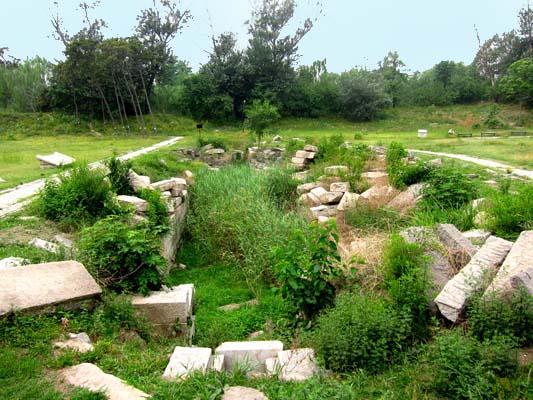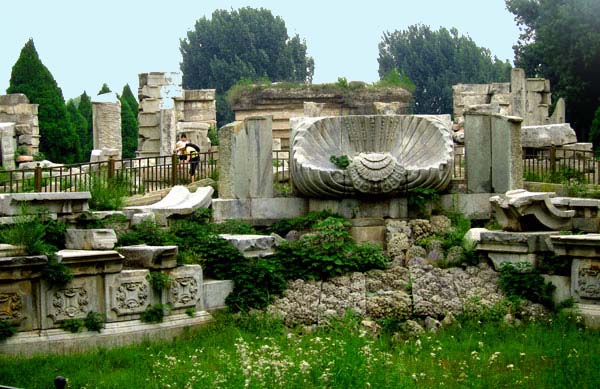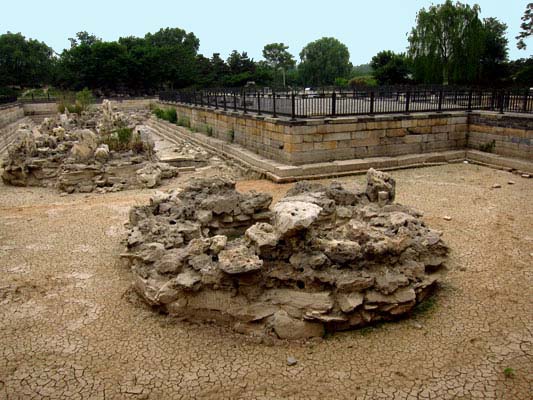
Beijing's park life - The Old Summer Palace
CRI, June 4, 2012
-

The sole bridge that escaped the palace's destruction in the 19th century.
In places, the Chinese capital's lack of colour puts the beige in Beijing. It's not the greenest of cities, but at least it has a multitude of parks to offer solace to the soul. Whether you're looking for a sense of community or a respite from the urban rush, you can find it in one of Beijing's parks. Parks are perfect places to be alone, or with family, friends or lovers.
CRI's William Wang strolls along countless quiet pathways in order to tell you about Beijing's unmissables.
The Old Summer Palace
The ruins of Bitong Shuyuan.
"It's pretty boring," commented one traveler about the Old Summer Palace. "The temple's destroyed so there's nothing to see," she concluded. This view is not unjustified if one goes to the Old Summer Palace expecting to be entertained or intellectually stirred. Yes, there is history to be had, but what remains of the luxurious palace is mostly unmowed grass.
Tragic as this is, what was once the exclusive territory of the imperial family has been converted into a massive park for the public to explore. Almost five times the size of the Forbidden City, it's not the kind of place that you want to see in a hurry.
The palace and its gardens date back to the 12th century, having gone through numerous stages of development. In the 18th century, Emperor Qianlong discovered a fondness for French and Italian architecture and accordingly ordered ten palaces to be built in the rococo style. When wandering through the park, visitors will differentiate the European ruins from the Chinese ones by the detailing in the stone.

A European style fountain in the ruins of Xiyang Lou section.
The park is divided up into three sections: Yuanmingyuan (Garden of Perfection and Light) in the west, Wanchunyuan (Garden of 10,000 Springs) in the south, and Changchunyuan (Garden of Everlasting Spring). Each section has its own lake and maze of waterways.
Xiyang Lou (Ruins of the European Style Palace) is located in the Changchunyuan section, and visitors should not miss it. This seven hectare area costs an additional 15 yuan to enter, but is well worth it.
Designed by an Italian court painter and a French engineer, the palaces here included a number of ornate fountains. Once stately columns and platforms have been reduced to chunks of stone surrounded by winding weeds. They are all that remain from when French and British troops burned the palace down. But somehow enough remains to give some feeling about the opulence which once existed on the site.

The winding passages of 10,000 Flower Maze.
At Wanhua Zhen (10,000 Flower Maze), the walkthrough maze and central pavilion have been reconstructed. The emperor once sat at centre and watched his concubines race through winding passages to find him. Today you can sit at centre and chuckle at tourists who run into dead ends. Wanhua Zhen is a classic example of how eastern and western design elements came together, complimenting each other.
To the west of Yuanmingyuan is the least frequented section of the park, which only opened in 2008. This massive new area is the perfect place for those looking for a little peace and quiet. It has a calming plentitude of green pastures, winding streams and quiet tree-sheltered walkways. Ruins are scattered throughout, with signage explaining which empress fancied staying there, or how emperors would feed the fish at such and such a fountain.
But on the whole, this is the section where nature prevails. Ideal for romantic strolls, there are plenty of nooks and crannies to find a bit of tender seclusion.

The ruins of Tantan Dangdang, where emperor Tangxi enjoyed feeding his thousands of goldfish.
Beautiful as the grounds are, it's difficult to walk through the Old Summer Palace without twinges of melancholy. About what once was and no longer is. About war and conflict. About art and the ephemeral.
Even the soldiers who were ordered to destroy the palace were awed by its original beauty. "You can scarcely imagine the beauty and magnificence of the places we burnt," wrote one captain. "It made one's heart sore to burn them...It was wretchedly demoralizing work for an army."
Acclaimed French writer Victor Hugo had much admiration for the Summer Palace, and much sorrow over its destruction. "All the treasures of all our cathedrals put together could not equal this formidable and splendid museum of the Orient," he wrote.
One can only hope that if Hugo were here today he could find some solace in the breeze dancing along the shore, or the wild thistles blossoming in the tall grasses.
Location: 28 West Qinghua Road, Haidian District. At Yuanmingyuan subway station.
Admission: 10 rmb. 15 rmb extra to enter Xiyang Lou area.
Opening hours: 7:00-21:00 (summer). 7:00 – 19:30 (winter)